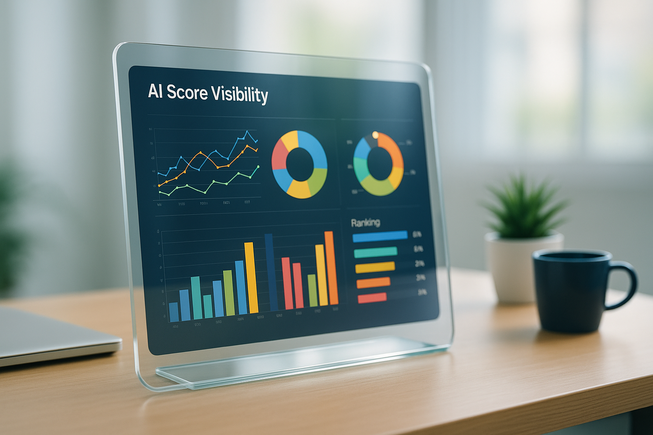How to Build Executive-Ready AI Visibility Metrics for Different Stakeholders in 2026
As an e-commerce leader or digital marketing executive, you’ve mastered the art of reporting on traditional performance channels. Your monthly dashboard likely includes SEO rankings, marketplace visibility, paid media performance, and conversion metrics across your digital properties. But there’s a critical blind spot in most executive reporting: how your products appear in Large Language Model (LLM) recommendations and answers.
AI visibility has rapidly evolved from an emerging concern to a mission-critical KPI, with LLM-influenced purchases now representing over $300 billion in annual consumer spending – yet fewer than 15% of brands have systematic reporting on this growing channel.
This reporting gap doesn’t just represent missing data. It creates significant business risk as AI platforms increasingly influence consumer purchase decisions while most organizations lack visibility into how their products are represented in these influential recommendations. Without clear metrics, executives can’t make informed decisions about resource allocation, competitive response, or performance optimization in this rapidly growing channel.
In this comprehensive guide, we’ll provide executive-ready reporting frameworks for AI visibility, share examples of effective metrics for different stakeholders, and outline implementation approaches that balance comprehensive coverage with practical resource constraints.
Jump to a specific section in this article ↓↓
- WHY LLM VISIBILITY REPORTING MATTERS NOW
- ESSENTIAL METRICS FOR EXECUTIVE REPORTING
- STAKEHOLDER-SPECIFIC REPORTING FRAMEWORKS

WHY LLM VISIBILITY REPORTING MATTERS NOW
Before diving into reporting frameworks, it’s essential to understand why LLM visibility has become a critical business metric requiring executive attention.
The Scale and Growth of LLM-Influenced Commerce
Recent data reveals the rapidly expanding influence of AI systems on purchase decisions:
Consumer adoption statistics:
- 43% of consumers now regularly use AI tools for product research before purchasing
- 61% of younger consumers (18-34) consider AI recommendations in their decision process
- 37% of high-income shoppers ($100K+) report AI recommendations have directly influenced a purchase in the past month
Market impact figures:
- $310 billion in annual consumer spending influenced by AI recommendations (2026 estimate)
- 28% annual growth rate in AI-influenced commerce
- Certain categories seeing 40%+ of research conducted through AI channels
Behavioral shifts:
- 73% of AI users report reduced traditional website browsing
- 64% indicate decreased comparison shopping across multiple sites
- 57% spending less time reading individual product reviews
These statistics reveal not just a new channel, but a fundamental shift in consumer research behavior that directly impacts purchase decisions across categories.
The Executive Visibility Crisis
Despite this growing influence, most organizations lack clear reporting on their AI visibility:
Current reporting limitations:
- 85% of brands have no systematic reporting on AI visibility
- 92% of executives report “low confidence” in understanding how their products appear in AI recommendations
- 73% cannot identify which products appear most frequently in AI responses
- 89% lack competitive benchmarking for AI visibility
Strategic implications:
- Resource allocation decisions made without visibility into a growing influence channel
- Competitive threats developing without detection
- Product performance attribution missing a significant touchpoint
- Strategic planning occurring without critical market data
This visibility gap represents both risk and opportunity – organizations that establish clear reporting gain strategic advantage in understanding and optimizing this growing channel.
Using tools like TrackBuy’s free AI Bot Checker, brands can verify whether AI systems can even access their product information – the essential first step in developing meaningful visibility reporting.
Why Traditional Metrics Miss the AI Impact
Traditional digital metrics fail to capture LLM visibility for several fundamental reasons:
Attribution disconnects: LLM research typically doesn’t pass referral data when consumers subsequently search for recommended products, creating “dark” touchpoints in the customer journey.
Non-click interactions: Unlike traditional channels where clicks and sessions are primary metrics, LLM influence often occurs through information delivery without click-through actions.
Synthesis rather than display: LLMs don’t simply display your content – they interpret, synthesize, and generate recommendations based on multiple information sources, making traditional impression metrics inadequate.
Multi-platform fragmentation: LLM interactions happen across diverse platforms (ChatGPT, Claude, Gemini, Perplexity, specialized assistants), creating fragmented visibility that standard tools don’t consolidate.
These fundamental differences necessitate new reporting approaches designed specifically for the unique characteristics of LLM-influenced commerce.
↑↑ Back to the list at the top ↑↑

ESSENTIAL METRICS FOR EXECUTIVE REPORTING
Effective LLM visibility reporting requires metrics that capture both presence and accuracy across AI platforms.
Core Visibility and Presence Metrics
The foundation of LLM visibility reporting begins with understanding where and how your products appear:
AI Visibility Index: The percentage of relevant category queries where your products appear in responses across major AI platforms. This baseline metric establishes whether you’re present in relevant conversations.
Mention Share: Your percentage of total product mentions within your category. Similar to share of voice in social listening or share of shelf in retail, this metric shows your relative visibility compared to competitors.
Visibility by Platform: Breakdown of visibility across specific AI platforms (e.g., ChatGPT, Claude, Gemini). Important for identifying platform-specific strengths or weaknesses.
Visibility Trend: Month-over-month or quarter-over-quarter visibility changes, highlighting improving or declining presence.
These presence metrics answer the fundamental question: “Are we showing up when consumers ask about our product category?”
Accuracy and Representation Metrics
Beyond simple presence, how accurately your products are represented is equally critical:
Accuracy Score: The percentage of AI product mentions that contain completely accurate information about specifications, pricing, and availability. Our research shows 47% of product mentions contain at least one factual error.
Pricing Accuracy Rate: Specifically tracks correct pricing representation, a particularly sensitive metric with direct conversion impact. Price errors appear in 31% of AI product mentions.
Specification Accuracy: Measures correct representation of product features and capabilities, essential for proper competitive positioning.
Authority Citation Rate: The percentage of product mentions where your official content is cited as a source rather than third-party information.
These accuracy metrics address the crucial question: “When we do appear, is our product information correct?”
Competitive Positioning Metrics
How your products appear relative to competitors provides essential strategic context:
Category Recommendation Rate: The percentage of category recommendation queries where your products appear, indicating default status in the category.
Attribute Association Score: Measures how frequently your products are associated with key category attributes (e.g., “best battery life,” “most durable,” “highest value”).
Comparative Mention Position: When multiple products are mentioned, tracks your average position in the recommendation sequence (first, second, third, etc.).
Competitive Accuracy Disparity: Identifies whether your products experience higher or lower error rates compared to competitors.
These competitive metrics help answer: “How do we compare to competitors in AI visibility and accuracy?”
Implementation-Ready Metric Definitions
For practical implementation, each metric requires clear definition and calculation methodology:
AI Visibility Index calculation:
- Identify statistically significant sample of category queries
- Track product mentions across major AI platforms
- Calculate percentage of queries where your products appear
- Weight by platform market share if desired
Accuracy Score methodology:
- Compare AI-generated product descriptions against authoritative sources
- Identify discrepancies in specifications, pricing, availability
- Calculate percentage of mentions with complete accuracy
- Optionally weight by severity of inaccuracies
Competitive Positioning approach:
- Track both your products and key competitors across same query set
- Calculate relative mention frequencies and positions
- Identify pattern differences in representation and accuracy
- Benchmark against market share for context
Using specialized AI visibility monitoring tools like TrackBuy allows brands to implement these metrics systematically across multiple products and AI platforms.
↑↑ Back to the list at the top ↑↑

STAKEHOLDER-SPECIFIC REPORTING FRAMEWORKS
Different stakeholders need different views of LLM visibility data. Effective reporting adapts metrics and presentation to specific audience needs.
C-Suite and Executive Leadership Reporting
Senior executives typically need high-level, business-focused reporting:
Key metrics for executive dashboards:
- Overall AI Visibility Index compared to previous period
- Visibility trend over 6-12 months
- Competitive position (share of category mentions)
- Accuracy rate with financial impact estimation
- Platform breakdown showing relative strengths/weaknesses
Presentation approach:
- Simplified visualization with clear trend indicators
- Competitor comparison emphasis
- Business impact framing rather than technical details
- Forward-looking implications alongside current metrics
- Limited to 3-5 key metrics for clarity
Update frequency: Monthly or quarterly reporting typically provides sufficient strategic insight without overwhelming detail.
Marketing and Digital Team Reporting
Marketing teams need more granular, actionable reporting:
Key metrics for marketing dashboards:
- Product-level visibility breakdowns
- Query-type performance analysis
- Platform-specific metrics with action recommendations
- Content gap identification
- Feature association tracking
Presentation approach:
- Detailed data tables with visualization options
- Historical trending with milestone annotations
- Campaign impact correlation
- Actionable insight highlighting
- Integration with other channel metrics when possible
Update frequency: Weekly or bi-weekly reporting supports tactical optimization and campaign monitoring.
Product Management Reporting
Product teams require specific feature and specification focus:
Key metrics for product dashboards:
- Feature-level visibility and accuracy
- Comparative feature positioning versus competitors
- Product line relationship representation
- New product visibility ramp metrics
- Specification error identification
Presentation approach:
- Feature-centric organization
- Product line comparisons
- Specification accuracy details
- Competitive feature positioning emphasis
- Integration with product roadmap milestones
Update frequency: Monthly reporting aligned with product development cycles, with capability for ad-hoc reporting during launches.
Investor and Board Reporting
External stakeholders need context-rich but accessible reporting:
Key metrics for investor presentations:
- Category-level AI visibility position
- Competitive benchmark comparisons
- Growth trends with market context
- Revenue impact estimation
- Strategic initiative progress
Presentation approach:
- Simplified visualization with minimal technical terminology
- Industry context and benchmark emphasis
- Clear connection to business outcomes and strategy
- Forward-looking implications
- Concise executive summary format
Update frequency: Quarterly reporting aligned with financial reporting cycles provides appropriate strategic visibility without tactical details.
↑↑ Back to the list at the top ↑↑


Leave a Reply